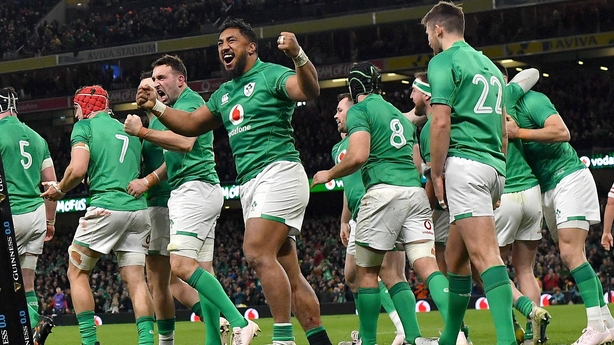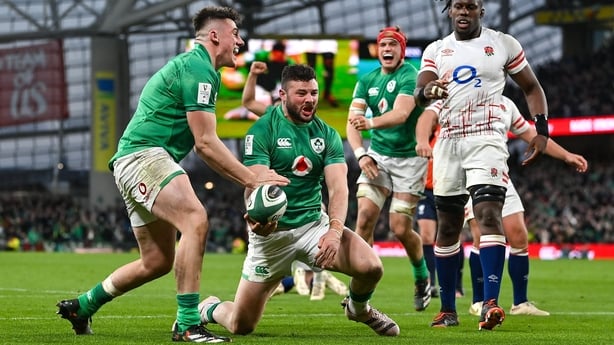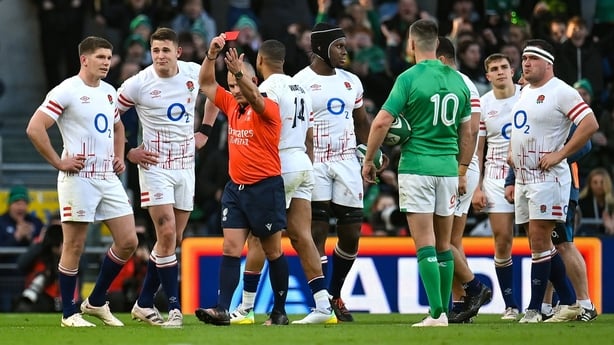When this Irish side are in top gear, they're a sight to behold.
Saturday wasn't one of those days, an evening where the size of the occasion dictated the need for substance above style, but throughout this Grand Slam run, and throughout the last 18 months, the attacking shape, variety of passing and moments of individual brilliance have made Irish games a joy to watch.
With four try-bonus points in the five wins, theirs has been the most dominant Grand Slam success since the bonus point system was introduced six years ago. By contrast, the 2019 Welsh Grand Slammers achieved their title without a single four-try win.
Twenty tries in five games, and an average of 30 points scored per game will win you a title most years, but those eye-catching numbers are built on the boring, sensible foundations which Ireland are laying better than anybody else in the world.
Defence, discipline and workrate have allowed Ireland to scorch through teams on the days when their attack has been hot. On days - like Saturday - when it's been cold, it's allowed them to simply get the job done.

A missed tackle count of 120 in five games doesn't look great in isolation, but it's a figure that doesn't tell the full story. With a player like Garry Ringrose, who always has a handful of misses in every game, it's his aggressive style that sends ball carriers back into traffic. A missed tackle from one player in the right area, could lead to a dominant tackle for someone else.
The defensive unit as a whole has been performing at the highest level for some time now. As pointed out by rugby statistician Russ Petty, the 10 tries that Ireland have conceded across the last two Six Nations championships combined are still two fewer than next-best Scotland conceded in this campaign alone.
Across five games, Farrell's side never trailed by more than six points, and were behind on the scoreboard for a combined 54 minutes over the whole championship, while any deficit they had to overcome had been done so by half-time.
In terms of workrate, they were several levels above the rest. In the lead up to their 32-19 win against France, James Lowe bullishly said he believed his side to be fitter than the bigger and more physical French, and those words rang true as Ireland pulled clear in the second half, even as their injuries mounted.
So many of their tries in this campaign can be pinned down to players relentlessly looking for work. The field position for their crucial second try from Robbie Henshaw (below) on Saturday came about after a brilliant kick-chase from the centre, as well as Hansen and Jimmy O'Brien which forced Anthony Watson back over his own line.

Against Scotland, it was Hansen's chase of Gibson-Park's box-kick which brought Ireland into the 22 and allowed Lowe to score a try moments later, while Hugo Keenan's opener against France, and Caelan Doris's score against Wales can both date back to Lowe kicking deep to the corner, and the supporting kick-chase forcing opponents into touch close to their own line.
They had the best discipline, with just 44 penalties conceded across their five games, but there is scope for improving the areas they're conceding in, with 12 of those penalties leading to shots at goal from the opposition, allowing France and England to stay in touch on the scoreboard for longer than they should have been.
Since Bundee Aki's red card against England two years ago, Ireland have given up just two yellow cards in 21 games, by some distance the cleanest record of the Six Nations and Rugby Championship big-hitters
It might seem unfair to pick out an individual, but Andrew Porter found himself on the wrong side of referees too often in the championship, his individual tally of 13 being the highest in the Six Nations and roughly 30% of Ireland's team total. There's no doubt the Leinster loosehead is world class operator and his ability to play close to 80 minutes week-on-week sets him apart from almost any other prop in the game, but refining that discipline will be a priority heading towards the World Cup.
That figure of 44 penalties is reflected better when you factor how aggressively Ireland compete at the breakdown, winning 35 turnovers, 12 more than any other side. Not all of those were won at the breakdown, but the fact that they were able to marry a high turnover count with a low penalty count speaks to a highly intelligent, well-coached side.

The second element of their discipline is the most important one. It's hardly the most insightful analysis, but the best team in the world are also the best at keeping 15 players on the field. Who would have thought?
Since Bundee Aki's red card against England two years ago, Ireland have given up just two yellow cards in 21 games, by some distance the cleanest record of the Six Nations and Rugby Championship big-hitters, with France's three yellows and two reds across the same number of games the closest in the fair play stakes.
In the same period of time New Zealand have played 27 games and had 14 yellows and three reds, while Australia have conceded 23 yellows and three red cards in their last 28 outings, averaging close to a card per game. And with the Super Rugby franchises still burying their heads in the sand with their 20 minute red card trial, it's hard to see them turning those figures around in time for the World Cup.
There have obviously been a few close calls with cards for Ireland over the past two seasons, but even accounting for a slice of luck their ability to avoid TMO checks and foul play referrals compared to the rest of their competition - in a time when there is such a high profile clampdown on head-high hits - points to a huge amount of work being done on the training ground and analysis room to make sure they are maximising themselves in the contact area.
All those fundamentals add up.







